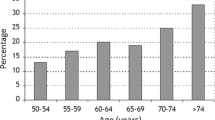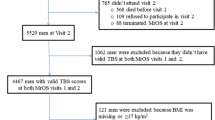Abstract
Summary
We studied the nature of the relationship between bone mineral density (BMD) and the risk of death among elderly men. BMD was associated with mortality risk and was independent of adjustments for other co-morbidities. A piecewise linear function described the relationship more accurately than assuming the same gradient of risk over the whole range of BMD (p = 0.020). Low BMD was associated with a substantial excess risk of death, whilst a higher than average BMD had little impact on mortality.
Introduction
Previous studies have demonstrated an association between low BMD and an increased risk of death among men and women. The aim of the present study was to examine the pattern of the risk in men and its relation to co-morbidities.
Methods
We studied the nature of the relationship between BMD and death among 3,014 elderly men drawn from the population and recruited to the MrOS study in Sweden. Baseline data included general health questionnaires, life style questionnaires and BMD measured using DXA. Men were followed for up to 6.5 years (average 4.5 years). Poisson regression was used to investigate the relationship between BMD, co-morbidities and the hazard function of death.
Results
During follow-up, 382 men died (all-cause mortality). Low BMD at all measured skeletal sites was associated with increased mortality. In multivariate analyses, the relationship between BMD and mortality was non-linear, and a piecewise linear function described the relationship more accurately than assuming the same gradient of risk over the whole range of BMD (p = 0.020).
Conclusions
Low BMD is associated with a substantial excess risk of death compared to an average BMD, whereas a higher than average BMD has a more modest effect on mortality. These findings, if confirmed elsewhere, have implications for the constructing of probability-based fracture risk assessment tools.



Similar content being viewed by others
References
World Health Organisation (1994) Assessment of fracture risk and its application to screening for postmenopausal osteoporosis. WHO technical report series 843. WHO, Geneva
Kanis JA, on behalf of the World Health Organization Scientific Group (2008) Assessment of osteoporosis at the primary health-care level. Technical report. WHO Collaborating Centre, University of Sheffield, UK
Marshall D, Johnell O, Wedel H (1996) Meta-analysis of how well measures of bone mineral density predict occurrence of osteoporotic fractures. Br Med J 312:1254–1259
Johnell O, Kanis JA, Oden A, Johansson H, De Laet C, Delmas P, Eisman JA, Fujiwara S, Kroger H, Mellstrom D, Meunier PJ, Melton LJ 3rd, O'Neill T, Pols H, Reeve J, Silman A, Tenenhouse A (2005) Predictive value of BMD for hip and other fractures. J Bone Miner Res 20:1185–1194
Browner WS, Seeley DG, Vogt TM, Cummings SR (1991) Non-trauma mortality in elderly women with low bone mineral density. Study of osteoporotic fractures research group. Lancet 338:355–358
Johansson C, Black D, Johnell O, Oden A, Mellstrom D (1998) Bone mineral density is a predictor of survival. Calcif Tissue Int 63:190–196
von der Recke P, Hansen MA, Hassager C (1999) The association between low bone mass at the menopause and cardiovascular mortality. Am J Med 106:273–278
Trivedi DP, Khaw KT (2001) Bone mineral density at the hip predicts mortality in elderly men. Osteoporos Int 12:259–265
Van Der Klift M, Pols HA, Geleijnse JM, Van Der Kuip DA, Hofman A, De Laet CE (2002) Bone mineral density and mortality in elderly men and women: the Rotterdam study. Bone 30:643–648
Mussolino ME, Madans JH, Gillum RF (2003) Bone mineral density and mortality in women and men: the NHANES I epidemiologic follow-up study. Ann Epidemiol 13:692–697
Pinheiro MM, Castro CM, Szejnfeld VL (2006) Low femoral bone mineral density and quantitative ultrasound are risk factors for new osteoporotic fracture and total and cardiovascular mortality: a 5-year population-based study of Brazilian elderly women. J Gerontol A Biol Sci Med Sci 61:196–203
Mussolino ME, Gillum RF (2008) Low bone mineral density and mortality in men and women: the Third National Health and Nutrition Examination survey linked mortality file. Ann Epidemiol 18:847–850
Suzuki T, Yoshida H (2009) Low bone mineral density at femoral neck is a predictor of increased mortality in elderly Japanese women. Osteoporos Int 21:71–79
Nguyen ND, Center JR, Eisman JA, Nguyen TV (2007) Bone loss, weight loss, and weight fluctuation predict mortality risk in elderly men and women. J Bone Miner Res 22:1147–1154
Orwoll E, Blank JB, Barrett-Connor E, Cauley J, Cummings S, Ensrud K, Lewis C, Cawthon PM, Marcus R, Marshall LM, McGowan J, Phipps K, Sherman S, Stefanick ML, Stone K (2005) Design and baseline characteristics of the osteoporotic fractures in men (MrOS) study—a large observational study of the determinants of fracture in older men. Contemp Clin Trials 26:569–585
Mellstrom D, Vandenput L, Mallmin H, Holmberg AH, Lorentzon M, Oden A, Johansson H, Orwoll ES, Labrie F, Karlsson MK, Ljunggren O, Ohlsson C (2008) Older men with low serum estradiol and high serum SHBG have an increased risk of fractures. J Bone Miner Res 23:1552–1560
Mellstrom D, Johnell O, Ljunggren O, Eriksson AL, Lorentzon M, Mallmin H, Holmberg A, Redlund-Johnell I, Orwoll E, Ohlsson C (2006) Free testosterone is an independent predictor of BMD and prevalent fractures in elderly men: MrOS Sweden. J Bone Miner Res 21:529–535
Lewis CE, Ewing SK, Taylor BC, Shikany JM, Fink HA, Ensrud KE, Barrett-Connor E, Cummings SR, Orwoll E (2007) Predictors of non-spine fracture in elderly men: the MrOS study. J Bone Miner Res 22:211–219
Looker AC, Wahner HW, Dunn WL, Calvo MS, Harris TB, Heyse SP, Johnston CC Jr, Lindsay R (1998) Updated data on proximal femur bone mineral levels of US adults. Osteoporos Int 8:468–489
Lu Y, Fuerst T, Hui S, Genant HK (2001) Standardization of bone mineral density at femoral neck, trochanter and Ward's triangle. Osteoporos Int 12:438–444
Washburn RA, Smith KW, Jette AM, Janney CA (1993) The Physical Activity Scale for the Elderly (PASE): development and evaluation. J Clin Epidemiol 46:153–162
Breslow NE, Day NE (1987) Statistical methods in cancer research. Volume II—the design and analysis of cohort studies. IARC Sci Publ 82:1–406
Good P (ed) (2000) Permutation tests. Springer, New York
Kanis JA, Oden A, Johnell O, De Laet C, Jonsson B, Oglesby AK (2003) The components of excess mortality after hip fracture. Bone 32:468–473
Kanis JA, Oden A, Johansson H, Borgstrom F, Strom O, McCloskey E (2009) FRAX and its applications to clinical practice. Bone 44:734–743
Conflicts of interest
None.
Author information
Authors and Affiliations
Corresponding author
Rights and permissions
About this article
Cite this article
Johansson, H., Odén, A., Kanis, J. et al. Low bone mineral density is associated with increased mortality in elderly men: MrOS Sweden. Osteoporos Int 22, 1411–1418 (2011). https://doi.org/10.1007/s00198-010-1331-1
Received:
Accepted:
Published:
Issue Date:
DOI: https://doi.org/10.1007/s00198-010-1331-1




